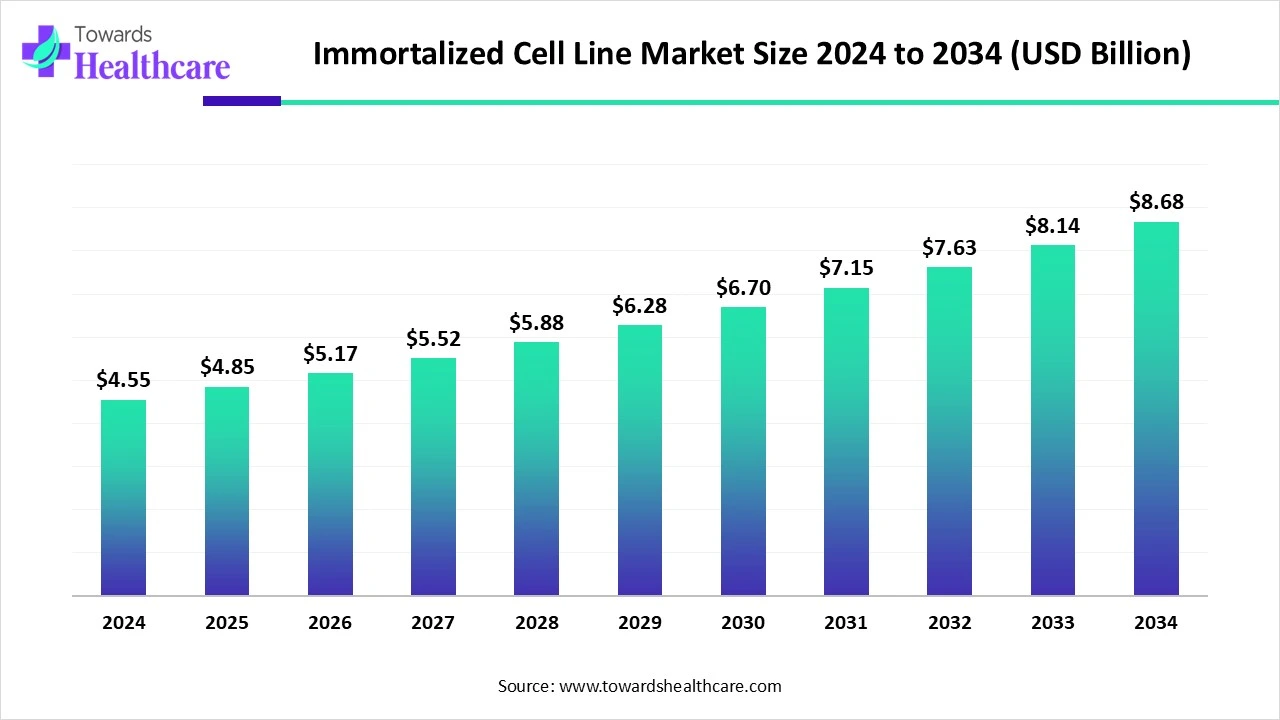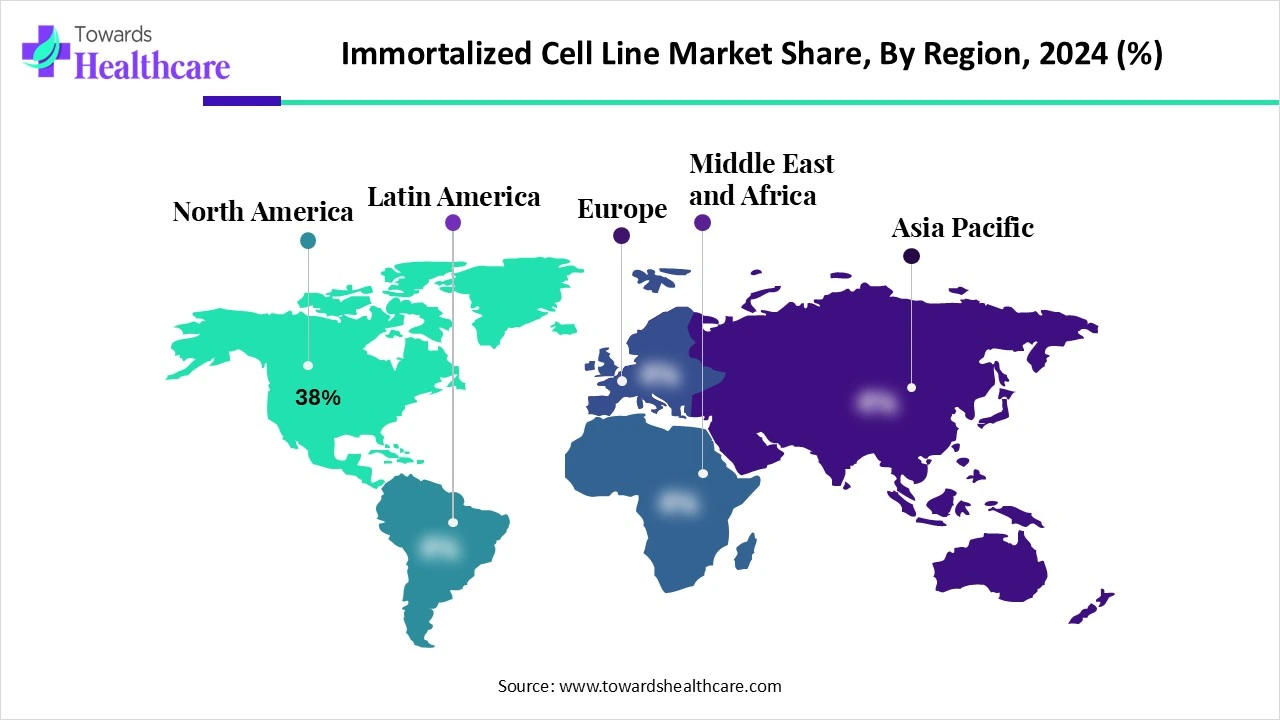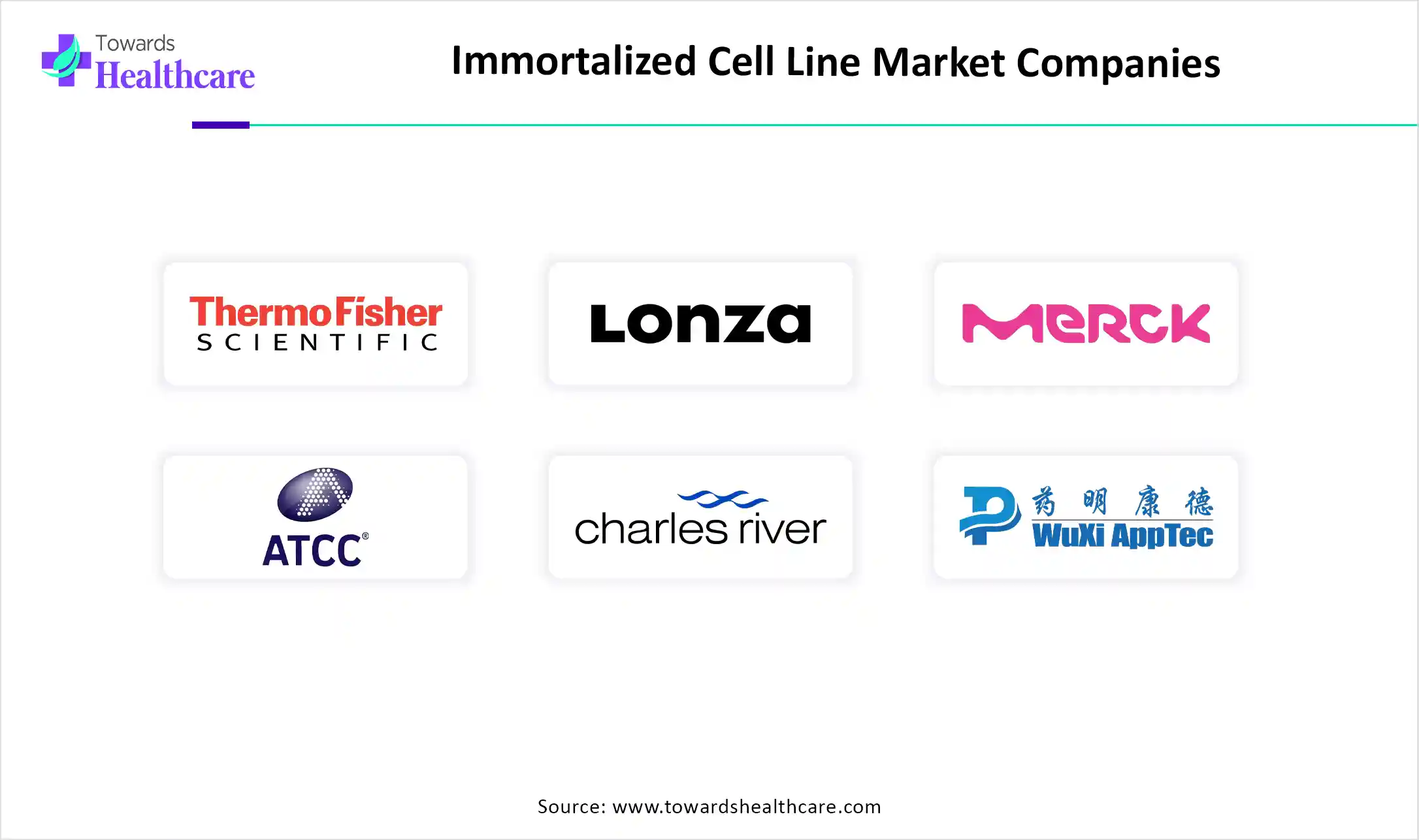November 2025

The global immortalized cell line market size is calculated at USD 4.55 billion in 2024, grow to USD 4.85 billion in 2025, and is projected to reach around USD 8.68 billion by 2034. The market is expanding at a CAGR of 6.71% between 2025 and 2034.
The immortalized cell line market refers to the industry focused on the production and application of cell lines that can proliferate indefinitely due to genetic modifications or mutations. These cell lines are widely used in drug discovery, vaccine production, cancer research, and toxicity testing because they offer consistency, scalability, and cost-efficiency. The market is growing due to rising demand for reliable in vitro models, advancements in biotechnology, and the need for high-throughput screening in pharmaceutical and biomedical research.

| Metric | Details |
| Market Size in 2025 | USD 4.85 Billion |
| Projected Market Size in 2034 | USD 8.68 Billion |
| CAGR (2025 - 2034) | 6.71% |
| Leading Region | North America share by 38% |
| Market Segmentation | By Product Type, By Method of Immortalization, By Application, By End Use, By Regions |
| Top Key Players | Thermo Fisher Scientific, Lonza Group AG, Merck KGaA (Sigma-Aldrich), American Type Culture Collection (ATCC), Corning Incorporated, Charles River Laboratories, WuXi AppTec, Selexis SA, Horizon Discovery Group (PerkinElmer), Cell Biolabs Inc., Creative Biolabs, Applied Biological Materials (ABM), Innoprot, CELLnTEC Advanced Cell Systems, Sartorius AG, Eurofins Scientific, GenScript Biotech, Evotec SE, BioIVT, Creative Bioarray |
The immortalized cell line market refers to the global commercial landscape involved in the development, production, characterization, and application of cell lines that have been genetically or chemically modified to proliferate indefinitely. Unlike primary cells, immortalized cell lines can bypass cellular senescence, making them invaluable for biological research, drug discovery, vaccine production, toxicity testing, gene expression studies, and biomanufacturing. These cell lines offer consistency, scalability, and reproducibility traits critical for both academic and industrial purposes. The immortalized cell line market is evolving due to advancements in genetic engineering and rising demand for reproducibility. These cell lines enable efficient high-throughput screening and long-term research. Growth is further supported by increasing chronic disease cases and the expanding use of in vitro models in therapeutic and technological studies.
AI is transforming the market by streamlining cell line development, optimizing culture conditions, and predicting cell behavior through advanced data analysis. It enables faster identification of ideal cell lines for specific applications, reducing time and costs in research and production. Additionally, AI enhances quality control and automation in bioprocessing, ensuring consistency and scalability. These capabilities are driving innovation and improving efficiency across drug discovery, vaccine development, and therapeutic manufacturing.
Growing Demand for Precision Medicine and Drug Discovery
The rising focus on precision medicine and innovative drug discovery is fueling the demand for immortalized cell lines, as they provide reliable and stable platforms for modelling human diseases. These cell lines support the screening of potential drug compounds on genetically defined cells, making it easier to tailor therapies for specific patient groups. Their consistency and scalability make them valuable tools in developing safer, more effective personalized treatments in modern biomedical research.
For Instance,
Ethical Concerns and High Development Costs
Immortalized cell lines face restraint due to ongoing ethical debates surrounding their origin, particularly when derived from human tissues without clear consent. These concerns can lead to strict regulations and hesitancy in research use. Additionally, the high financial burden associated with establishing and validating reliable cell lines, including advanced technology, skilled personnel, and quality control, makes, less feasible for many academic and smaller biotech institutions, thereby hindering broader market penetration and slowing innovation.
Adoption of Advanced Epigenetic Induction for the Development of Immortalized Cell Lines
Advanced epigenetic induction offers a novel approach to developing immortalized cell lines by reprogramming cells without altering their genetic code. These methods help retain the cells' nature characteristics, improving their reliability for research and therapeutic applications. It also minimizes the risk linked to traditional genetic manipulations. As pharmaceutical and biotech companies seek safer, more accurate models for testing and development, this technique is likely to drive innovation and unlock new opportunities in the global cell line market.
For Instance,
The human cell lines segment leads the market due to its close resemblance to actual human biology, enabling more accurate predictions of drug responses. These cell lines are increasingly preferred in biomedical research and clinical studies for their reliability and scalability. Growing investments in human-specific therapeutic development and expanding use in genetic and cancer research are also driving demand, positioning the segment for the fastest growth rate over the forecast period.
The viral-mediated immortalization segment led the immortalized cell line market in 2024 due to its high efficiency and ability to rapidly introduce immortalizing genes into primary cells. This method is widely used because it enables long-term cell proliferation while maintaining key cellular functions. It is especially effective for hard-to-immortalize cell types, making it a preferred choice in research and therapeutic development. Its consistent performance and scalability have further driven its dominance across academic, pharmaceutical, and biotechnology sectors.
The telomerase expression (hTERT-based) segment is expected to witness the fastest growth in the immortalized cell line market during the forecast period due to its ability to maintain cellular characteristics while enabling extended proliferation. Unlike other methods, it avoids disrupting key regulatory pathways, ensuring more biologically relevant results. This technique is gaining traction in areas like stem cell research, oncology, and tissue engineering. Its non-viral nature and improved safety profile make it a favorable option for long-term studies and therapeutic development. Driven by its market expansion.
For Instance,
The drug discovery & development segment dominated the immortalized cell line market in 2024, owing to its critical role in early-stage research and compound screening. These cell lines help streamline the evaluation of drug efficacy and safety before clinical trials, reducing both time and cost. Their ability to provide consistent biological responses makes them essential for identifying targeted therapeutic approaches, supporting the rising demand for innovative treatment, and accelerating pharmaceutical pipeline development, thereby driving market expansion.
For Instance,
The biologics manufacturing segment is expected to witness the fastest growth in the immortalized cell lines market due to the need for a stable, high-performance cell system in large-scale therapeutic production. These cell lines ensure reproductivity and efficiency in producing complex biologics, supporting streamlined manufacturing processes. With the growing pipeline of biologic drugs and increasing focus on biosimilars and cell-based therapies, manufacturers are turning to immortalized lines to meet manufacturers are turning to immortalized line to meet production demands, driving strong growth of the market.
The pharmaceutical & biotechnology companies segment accounted for the largest share of the largest shares of the immortalized cell line market as they require robust and reproducible cell models for developing new treatments. These forms extensively utilize immortalized cells in screening, mechanism studies, and biologic manufacturing. Their strong research infrastructure, high investment capacity, and continuous pursuit of innovative therapies contribute to their dominant position, making them the primary drivers for the research and commercial applications.
For Instance,
The contract manufacturing organizations (CMOs) segment is projected to expand rapidly due to the increasing need for flexible and efficient production solutions in the biopharmaceutical sector. As more companies aim to reduce operational costs and focus on core R&D, they are turning to CMOs for support in cell line development and biologic production. The specialized capabilities, advanced facilities, and faster turnaround times offered by CMOs are accelerating their adoption, fueling the strong growth during the forecast period.

North America led the market share 38% in 2024, due to its well-established biotechnology sector and access to cutting-edge laboratory technologies. The region's strong regulatory framework, skilled research workforce, and rising demand for innovative therapies have accelerated the use of immortalized cell lines in drug development and biologics manufacturing. Furthermore, continuous advancements in cell-based research and early adoption of emerging techniques have positioned North America at the forefront of this growing market.
The U.S. market is expanding due to increasing investments in biomedical research, rising demand for biologics, and a strong pharmaceutical industry. Advanced infrastructure, ongoing clinical trials, and a focus on precision medicine further drive growth. Additionally, supportive regulatory policies and innovation in cell line technologies are boosting market development in the country.
Canada's market is growing due to increased government funding for cell culture research and infrastructure, and a strong biopharmaceutical sector focused on biologics and regenerative medicine. Collaborations among companies for cell line development and a shift toward protein therapeutics are enhancing market growth. The use of cell lines in treatment options, aligned with regulatory guidelines, is also attracting patients and supporting market expansion.
Asia-Pacific is projected to grow at the fastest CAGR in the market due to rising healthcare investments, increasing demand for advanced cell-based research, and rapid expansion of the biotechnology sector. Countries like China, India, and South Korea are actively enhancing their research infrastructure and fostering public-private partnerships. Additionally, lower operational costs and growing interest in biologics production are attracting global players to establish manufacturing and R&D hubs in the region.
China's market is expanding due to robust government support for biotechnology, including initiatives like "Made in China 2025". The country has seen significant growth in its biopharmaceutical sector, with increased investments in research and development and a surge in clinical trials. Additionally, China's cost-effective manufacturing capabilities and a large pool of skilled professionals contribute to its rapid market growth. Collaborations with global pharmaceutical companies further enhance its position in the cell line development industry.
India’s market is growing due to strong government initiatives like the National Biopharma Mission and PLI schemes, which promote biotech innovation and manufacturing. The presence of skilled researchers, low operational costs, and rising demand for biosimilars and biologics further support growth. Increasing academic-industry collaborations also boost cell line research and development.
In 2024, Europe is strengthening its role in the market through increased government funding, strong biotech infrastructure, and cross-sector collaborations. Programs like Horizon Europe are boosting research into innovative, scalable cell lines for biologics and gene therapies. With leading countries such as Germany and the UK driving technological advancements, the region is focusing on ethical sourcing, high-efficiency cell systems, and expanding therapeutic applications.
The UK’s market is expanding due to its strong focus on cell and gene therapy, oncology biologics, and academic drug discovery collaborations. Research hubs like Cambridge and Oxford drive demand for customized, high-expression cell lines. Government support through Innovate UK and NIHR, along with advancements in AI and automation, further accelerates market growth.
Germany's market is expanding due to its robust biopharmaceutical sector, particularly in biologics and biosimilars, supported by government and EU funding for life science innovation. The adoption of advanced bioprocessing technologies and a strong focus on GMP-compliant cell banking enhances production capabilities. Additionally, the growth of contract development organizations in regions like Bavaria and Berlin strengthens service availability, contributing to market growth.

In June 2024, Israeli startup ProFuse Technology launched ‘PROFUSE-B8,’ a non-GMO, spontaneously immortalized bovine myoblast cell line for cultivated meat production. CEO Guy Nevo Michrowski stated it shows strong performance in both proliferation and muscle formation, saying, “It’s the only cell line ideal for muscle production without genetic modification.” ProFuse plans to license it and develop similar lines for pigs, sheep, poultry, and fish (Source - AFN)
By Product Type
By Method of Immortalization
By Application
By End Use
By Region
November 2025
November 2025
November 2025
November 2025